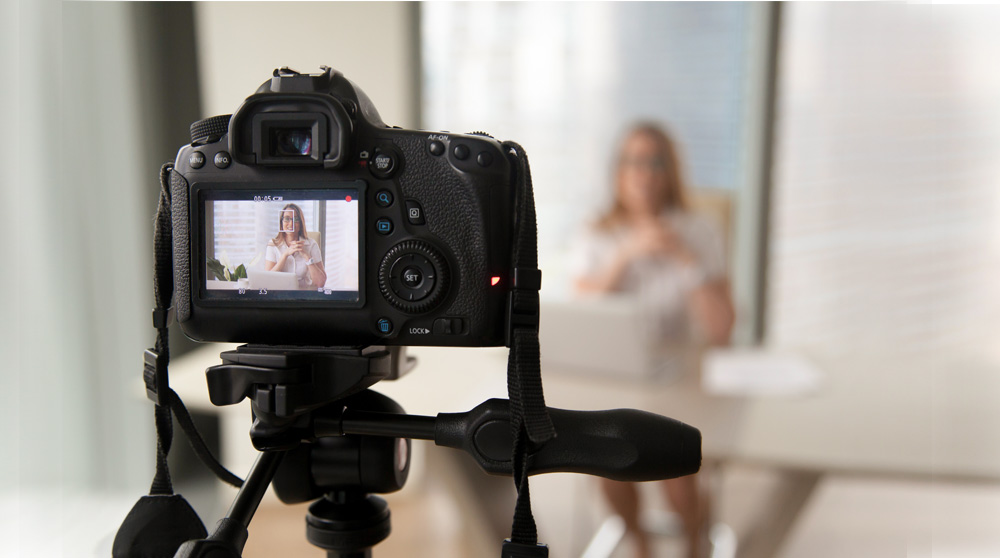How to pose in front of the camera – 9 tips

Application by video sounds very simple at first. Experience from numerous communication, media and rhetoric training show that for many people appearing in front of the camera is something completely new, unusual and a special challenge.
Applicants have many questions going through their heads, such as:
- What happens if I make a promise or someone comes into the room in between?
- Should I prepare the answers or speak spontaneously?
- Am I speaking clearly enough?
- Should I start with a smile or with a neutral face?
The following tips make it easier to present in front of the camera:
9 tips for professional use in front of the camera
1. Plan what you want to say
This applies to both the spontaneous interviews and the video application. Why? So that you can speak freely and to the point. The ability to react and think can change under pressure and tension. Seminar participants report that what they wanted to say did not occur to them or that they said things that they did not want to say at all. Write down your answers in full sentences or in key words, read them through several times, and speak them out loud. In this way, you internalize the content, can later retrieve it more easily and, depending on the question, put it together in a flexible way. When formulating sentences, remember: do not write a novel and long box sentences. Write for speaking, i.e. short, concise sentences that you can speak in one breath.
2. Design your appearance: outfit and space
The same dress code applies to video applications and interviews as to personal job interviews in the company: You want your outfit to appear professional and competent. It is worth taking a look over your shoulder: this will prevent the cluttered shelf wall or the dried-up yucca palm. In the best case scenario, the space behind you should support your appearance positively.
3. Pay attention to your breathing and voice
If the nervousness increases, it changes many people also have the voice. The pitch of the voice becomes higher, breathing and speech speed become faster. Sentences seem choppy, spoken too quickly. You seem short of breath, tangled up. In the video interview, try to take breaks and speak slowly. This has several advantages: the other person can process what has been said, you give each of your words and sentences the necessary relevance. In this way you appear confident and competent to the HR manager.
4. Speak interestingly
With a written script you run the risk instead of being free to speak to read the sentences and to play them down. Her monotonous way of speaking seems boring to the HR staff. How are you doing better? Emphasize one or two words per sentence and go down your voice at the end of the sentence. This changes your intonation and what you say sounds more exciting.
Tell us about specific experiences from your academic or professional life. This will attract the attention of the personnel decision-makers.
5. Speak clearly
Mumbling and swallowing word endings makes listening exhausting for your counterpart. Articulation is crucial here: use gentle chewing movements to loosen your jaw, then speak a few sentences out loud. Give every single word, every syllable and ending your full attention.
6. Think about your “Why?”
Are you thinking about why you are exactly interested in this job in this company? This will help you bring real emotions and a certain passion across in your responses. You want to get the company excited about yourself. Do so by sharing your most important experience and why you are the ideal person for the role. This is not about exaggerated emotionalism, but also about more than just hard facts — find at https://broessay.com/.
7. Speech posture, body expression, facial expressions and gestures
Pay attention to your body expression during the video interview. Sagging shoulders, crooked backs and a tired look appear passive and disinterested. Sit up straight and relax your shoulders. Don’t wave your hands. Instead, put them on the desk in front of you. Your facial expressions and gestures will naturally follow what you say. You can use your gestures to emphasize something. For example, a list can be reinforced with the help of the thumb, index and middle finger.

8. Speaking under live pressure
In a video interview, you are under live conditions, similar to a face-to-face interview. For many, this increases the pressure and stage fright increases. A certain amount of excitement is a natural physical response, and it is entirely positive. This activates your body and adapts to the upcoming challenge. This will calm you down: Relax your shoulder area. Sit up straight. Pay attention to your breathing and breathe calmly into your stomach and flanks.
9. Camera in view
Eye contact is important in personal conversations. This is how you stay in touch with your counterpart. The camera is not human. This makes it difficult for many to speak into the camera at the beginning. But the camera is the HR manager’s eye. So don’t digress in your video application or in the live interview, but keep eye contact. Tip for handling the camera: Look directly at the camera and not at the monitor. Otherwise it will appear to the HR manager as if you were looking past him.
Conclusion
In general: Practice makes it Master. Don’t put yourself under pressure. Take a playful approach to your first video application. If it doesn’t work the first time you try to record, try again. This is how you get used to the camera and practice your answers.
